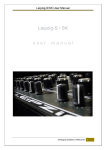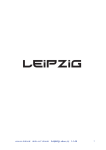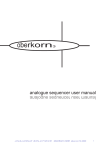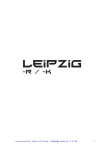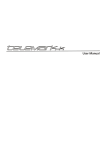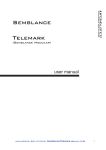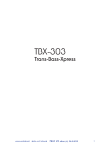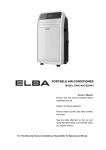Download Leipzig-S User Manual
Transcript
Leipzig-S User Manual Analogue Sequencer Synth/ Analogue Solutions Leipzig-S User Manual MANUAL OVERVIEW ........................................................................................................... 3 Using This Unit Safely ........................................................................................................... 4 Placement ......................................................................................................................... 6 Maintenance ...................................................................................................................... 6 Additional Precautions ....................................................................................................... 6 FRONT PANEL .............................................................................................................. 8 REAR PANEL ............................................................................................................... 8 co - Voltage control oscillators ............................................................................................ 9 VCO1 .......................................................................................................................... 10 VCO2 .......................................................................................................................... 11 MIXER ................................................................................................................................ 13 VC LPF – VOLTAGE CONTROLLED LOW PASS FILTER.............................................. 15 LFO – LOW FREQUENCY MODULATION ....................................................................... 16 MODULATION ................................................................................................................... 17 VCO1 ........................................................................................................................... 17 VCO2 .......................................................................................................................... 18 VCF ............................................................................................................................. 18 EG1 & EG2 - ENEVELOPE GENERATORS .................................................................... 20 VCA – VOLTAGE CONTROLLED AMPLIFIER ................................................................... 22 MODE ......................................................................................................................... 22 MIDI .................................................................................................................................... 23 PROGRAM...................................................................................................................... 23 SEQUENCER .................................................................................................................... 24 SYNC SOURCE .......................................................................................................... 24 RESET ........................................................................................................................ 25 STEP ........................................................................................................................... 25 STEP CV Knobs 1-8 ................................................................................................... 26 DESTINATION ............................................................................................................ 26 USING THE SEQUENCER AS AN AUDIO OSCILLATOR ........................................... 26 Specifications...................................................................................................................... 27 2 MANUAL OVERVIEW | Analogue Solutions Leipzig-S User Manual MANUAL OVERVIEW Though Leipzig-S has some very special features, the general architecture, signal flow, control naming etc is fairly standard, so using this synth should be fairly straightforward. If you have experience with other analogue synths you should be able to get this going without reading the manual! However, we advise you read the safety information and further read the rest to discover how to use some of the unique features. This manual does not aim to teach you the principles of analogue synthesis and assumes you have prior knowledge of analogue synths and their use. What this manual does is list the functions and their use. A quick web search will bring up plenty of general analogue synth tutorials and forums are always a good place to ask question about general synth use. Analogue Solutions | MANUAL OVERVIEW 3 Leipzig-S User Manual USING THIS UNIT SAFE LY Before using this unit read this instruction manual. Do not open or modify this unit or its power supply. Do not attempt to repair the unit or replace parts within it. Refer servicing to a qualified service engineer. Never use or store the unit in places that are; subject to extremes of temperature (such as in direct sunlight in an enclosed vehicle, on a heater or near a heating duct, etc). that are damp or wet (e.g. bathrooms), humid, exposed to rain, dusty, high levels of vibration. Make sure the unit is placed on a stable and level surface. Use only the specified AC adaptor. Make sure the mains voltage matches that of the adaptor. Ensure the correct polarity adaptor is used. Other adaptors could be of the wrong type of voltage or polarity and could result in damage, malfunction, or electric shock. Do not excessively bend or twist the adaptor cable. Doing so may damage the cable. Damaged cables could cause a malfunction, or a shock or fire hazard. Do not allow any small parts (like pins, coins), liquids, flammable material to enter the unit. Immediately disconnect the mains supply and adaptor, and contact a qualified service engineer; when the AC adaptor or power supply cord has been damaged, when objects have fallen onto, or a liquid has been spilled into the unit, when the unit has been exposed to rain or other liquids, when the unit does not appear to function correctly. When small children are present adult supervision must be provided. Protect the unit from strong impact, including being dropped. If the unit is sharing a power outlet with several other devices when using extension cords/multi-sockets, ensure the current rating of the cords/sockets are not exceeded. Before using the unit in a different country, check the mains supply is correct for the AC adaptor. When disconnecting the AC adaptor plug, always grasp it by the plug body, not the wire. When the unit is to remain unused for a length of time, disconnect the adaptor from the mains. Cables can be a risk to small children. Always place the out of reach. Never climb, or place objects on top of the unit. 4 Using This Unit Safely | Analogue Solutions Leipzig-S User Manual Never handle the unit, the AC adaptor, or any cables with wet or moist hands. Before cleaning the unit, disconnect from the mains. Whenever you suspect lightning in the area, disconnect the AC adaptor. Did you read all this? Good now you will be safe, but please still use what common sense health and safety assumes we all don’t have! Analogue Solutions | Using This Unit Safely 5 Leipzig-S User Manual I MP O R T A N T N O T E S PLACEMENT This device may interfere with radio and television reception. Do not use this device in the vicinity of such receivers. Do not expose the unit to direct sunlight or place it near devices that radiate heat, or leave inside an enclosed vehicle, or otherwise subject it to extremes of heat. Excessive heat may also discolour the unit. Do not use the unit in a wet area, or expose it to rain or moisture. MAINTENANCE For everyday cleaning, wipe it down with a dry soft cloth, or one that has been slightly dampened with water. To remove stubborn dirt, use a cloth impregnated with a mild nonabrasive detergent. Afterwards be sure to wipe the unit dry thoroughly with a dry cloth. Be sure to disconnect the AC adaptor before any cleaning. Never use benzene, thinners, alcohol or other such chemicals and solvents to clean the unit. ADDITIONAL PRECAUTIONS Use a reasonable amount of care when using the buttons and knobs. Unreasonable use or rough handling may cause damage or malfunctions. Never strike or apply strong pressure to the unit. When disconnecting or connecting any cable, hold the cable plug not the cable. Insert or remove straight and perpendicular to the case. To avoid disturbing your neighbours always keep your volume levels at a reasonable level. When transporting the unit use the original packaging. 6 Using This Unit Safely | Analogue Solutions Leipzig-S User Manual MAIN FEATURES Pure analogue voice and modulation circuitry. Fat Moog style filter. 2 VCOs with Glide and Sub-VCOs. Osc Sync & Cross-Mod Plenty of modulation routing possibilities. Analogue step sequencer – with plenty of clocking options. Audio input so can be used as a sound processor. Rugged steel/aluminium construction. MIDI In for software sequencer control. Analogue Solutions | Using This Unit Safely 7 Leipzig-S User Manual MAKING CONNECTIONS FRONT PANEL REAR PANEL Turn the input level down on your mixer. Connect AUDIO OUT to your mixer using a standard ¼” (6.35mm) mono jack cable. Connect the mains adaptor to the rear. Rotate the SEQ SYNC rotary switch in the lower left corner to LFO to start the sequencer. Slowly increase the level on your mixer to a suitable level. Note; you will have to adjust other controls on Leipzig to get a sound, like VOLUME, VCO Levels, Filter CUTOFF. Many settings will produce no sound! If you wish to play the synth with a MIDI sequencer or MIDI keyboard connect the controller’s MIDI OUT to Leipzig’s MIDI IN. 8 Using This Unit Safely | Analogue Solutions Leipzig-S User Manual TOUR OF THE CONTROLS VCO - VOLTAGE CONTROL OSCILLATORS The two VCOs are almost identical, but VCO1 has a manual pulse width control, and VCO2 has a Sync feature. Analogue Solutions | Vco - Voltage control oscillators 9 Leipzig-S User Manual VCO1 MASTER TUNE This tune control affects both VCOs. GLIDE This is a portamento function. Each note will glide to the next new note, slowly rising or failing in pitch to the new note. The Glide knob changes the rate (time) it takes to reach the new note. MANUAL PULSE WIDTH This changes the pulse width (duty cycle) of the square wave. Basically turn it and hear the effect it has on the sound of the square wave! PULSE WIDTH MODULATON 10 Vco - Voltage control oscillators | Analogue Solutions Leipzig-S User Manual This allows modulation of the Pulse Width of the square wave. It can be modulated by the LFO Triangle wave when turned left, or by Envelope1 when turned right. Centre position is off (no modulation). VCO2 TUNE This tune control only affects VCO2. GLIDE This is a portamento function. Each note will glide to the next new note, slowly rising or failing in pitch to the new note. The Glide knob changes the rate (time) it takes to reach the new note. SYNC Analogue Solutions | Vco - Voltage control oscillators 11 Leipzig-S User Manual Oscillator sync is where the VCO’s waveform can be reset by another signal. Don’t worry about the technicalities. Just use the feature and enjoy the sound! VCO2 can be sync’ed to VCO1 Square wave, LFO Square wave, External Signal 1, or it can be turned off. The best effect can be heard when set to VCO1. For an extreme sound modulate the pitch of VCO2. You may need to play around with the pitches of VCO1 and VCO2 to find a setting that works best. PULSE WIDTH MODULATON This allows modulation of the Pulse Width of the square wave. It can be modulated by the LFO Triangle wave when turned left, or by Envelope1 when turned right. Centre position is off (no modulation). MIDI PITCH This switch disconnects the Pitch control of VCO2 from MIDI, so it will no longer respond to MIDI note commands. It becomes a ‘free running oscillator’, ideal for modulation. 12 Vco - Voltage control oscillators | Analogue Solutions Leipzig-S User Manual MIXER There audio is mixed with the mixer before being fed to the input of the filter. Each control can choose between two signals. Centre is zero volume. As you gradually turn the control left or right you increase the level of the sound that is in the left or right position. Analogue Solutions | MIXER 13 Leipzig-S User Manual EXT2 / NOISE / SEQUENCER Left; changes the level of the signal coming into the EXT2. RIght; changes the level of either the White Noise generator or the Sequencer, depending on the position of the toggle switch. SUB-OSCILLATOR Left; changes the level of VCO1 Sub, which is one octave down from VCO1. RIght; changes the level of VCO2 Sub, which is two octaves down from VCO2. VCO1 14 MIXER | Analogue Solutions Leipzig-S User Manual Left; changes the level of VCO1 Sawtooth waveform. RIght; changes the level of VCO1 Square waveform. VCO2 Left; changes the level of VCO2 Sawtooth waveform. RIght; changes the level of VCO2 Square waveform. VC LPF – VOLTAGE CONTROLLED LOW PASS FILTER The Leipzig has a 24db/octave transistor ladder filter with a sound similar to the old Moog synths. CUTOFF This changes the cutoff frequency and changes how bright the sound can be. RESONANCE Sometimes called Q or Emphasis on other synths. This changes the Q, or feedback at the cutoff frequency. In simple terms, the squigyness of the sound! Analogue Solutions | VC LPF – VOLTAGE CONTROLLED LOW PASS FILTER 15 Leipzig-S User Manual KEY TRACK This control routes pitch CV to the filter cutoff. When it is turned up, as you play higher up the keyboard, the filter will open up. This makes the sound get brighter as you play up the keyboard. EG MODULATION This control routes either envelope to modulate the frequency cutoff. The centre position is off/no modulation. Modulation can be either EG1 (left) or EG2 (right). LFO – LOW FREQUENCY MODULATION The LFO produces both triangle and square waveform outputs. The LFO modulation signal is typically used to create ‘wah-wah’ or vibrato type os effects. RATE This control sets the speed of the LFO. 16 LFO – LOW FREQUENCY MODULATION | Analogue Solutions Leipzig-S User Manual MODULATION This section selects and routes various modulation signals to the VCO and VCF circuits. The three rotary switches select the modulation source, for example LFO or EG. The Level control sets the modulation level. Each circuit (VCO1, VCO2, VCF) has its own choice of modulations sources. VCO1 LFO TRIANGLE Ideal for vibrato effects. LFO SQUARE Analogue Solutions | MODULATION 17 Leipzig-S User Manual Ideal for special effects. EG1 Pitch sweeps. Extreme settings are good for percussion. VCO2 SQUARE Extreme settings create Ring-mod and metallic type sounds. VCO2 LFO TRIANGLE Ideal for vibrato effects. LFO SQUARE Ideal for special effects. EG2 Pitch sweeps. Extreme settings are good for percussion. MIDI CV2 (auxiliary CV/MIDI controller) controls pitch VCF 18 MODULATION | Analogue Solutions Leipzig-S User Manual LFO TRIANGLE Ideal for wah-wah effects. LFO SQUARE Ideal for special effects. VCO1 Use with fill Resonance for metallic type sounds. MIDI Control from auxiliary CV/MIDI controller. Balance this with filter cut-off and EG-Mod for create filter duynamics. Analogue Solutions | MODULATION 19 Leipzig-S User Manual EG1 & EG2 - ENEVELOPE GENERATORS Envelopes are modulation signals that you trigger and then they evolve over time. Typically used to change the volume or filter cutoff, though they can also be used to modulate the VCO pulse widths or pitch. Both envelopes are identical, so only one will be described! ATTACK This controls how low the EG takes to reach maximum level once triggered. DECAY After reaching maximum level following the Attach stage, Decay sets the time taken to reach the level set by Sustain. 20 EG1 & EG2 - ENEVELOPE GENERATORS | Analogue Solutions Leipzig-S User Manual SUSTAIN Once the Attack and Decay stages have passed, Sustain sets the level that the EG will hold its output at for as long as a key is held down. RELEASE Once the key is released, this sets the time take for the signal to fade to zero. LED The LED gives a rough approximation of output level. MIDI TRIG SWITCH. The EGs can be triggered from MIDI or the sequencer. When this switch is down it can be triggered from MIDI. Analogue Solutions | EG1 & EG2 - ENEVELOPE GENERATORS 21 Leipzig-S User Manual VCA – VOLTAGE CONTROLLED A MPLIFIER The VCA is an amplifier whose gain can be changed with a modulation signal, typically an envelope. There are four choices available on the rotary switch. MODE EG1 /EG2 Normal use to contour the volume. GATE The VCA opens and closes with no gradual attack or decay, much like an organ. THRU This holds the VCA open at full volume. This is typically used when feeding external audio into the synth. It can then be used like an effects processor. 22 VCA – VOLTAGE CONTROLLED AMPLIFIER | Analogue Solutions Leipzig-S User Manual MIDI MIDI control has been kept intentionally minimal. This is a ‘traditional’ true analogue synth. We don’t want you to get carried away micro-edititing controller values with your clever computer! There are three main elements you can control; Pitch CV (MIDI Note) – used to control the pitch of the VCOs. Gate (MIDI Note on/off) – used to trigger the envelopes or clock the sequencer. Auxiliary CV / CV2 – this is a modulation CV. It is controlled by either MIDI velocity or a MIDI Controller. PROGRAM This button is used to set the MIDI channel and CV2 controller. Works best if you plug a MIDI keyboard direct to program rather than via a DAW. The change the MIDI channel and CV2 controller; Press and hold the PROG button. Press a MIDI key or move a MIDI controller. Release the key/controller, then release the PROG button. The synth will set it’s MIDI receive channel to the same channel of the MIDI message that was received. CV2 will be set to Velocity if you used a MIDI key or to the same controller number of the controller that was moved. Analogue Solutions | MIDI 23 Leipzig-S User Manual SEQUENCER This is the fun bit Leipzig-S has a built in analogue step sequencer. It can be clocked from various sources and produces an analogue CV that can be used to modulate the VCOs or filter cut-off. It is fantastic as a modulation source. It can also be used to create simple melodies, that can be transposed with your MIDI keyboard. It can also be used as a simple waveform generator and then used as a new audio source that can be played and filtered. Note; it does not produce a MIDI output! This is an anague synth, after all! Think of this sequencer more as a modulation source, though of course you can create simple melodies. SYNC SOURCE The sequencer can be clocked from seven different sources; LFO Internal LFO becomes the clock source. VCO2 AUDIO VCO2 clock source becomes the clock source. This means the sequencer is running at audio frequencies! More on this later. MIDI KEY Sequencer advances one step each time a MIDI key is played. ACCENT 24 SEQUENCER | Analogue Solutions Leipzig-S User Manual Sequencer advances one step each time a MIDI key is played with a velocity over 80 (accented). EXT1 If a clock signal or LFO is fed into the EXT1 socket on the rear panel then that becomes the souce. MIDI-CV2 The auxiliary CV (controlled by MIDI velocity or MIDI controller) steps the sequencer. When the CV goes from 0v to approx. 2V the sequencer steps. MIDI SYNC The sequencer will run when it received MIDI Sync. It responds to Start and Stop messages too. RESET The sequencer can be reset to step one every time it receives a MIDI note whose velocity value is over 80 (accented). To do this ensure that the toggle switch is down. STEP The step button allows you to manually step the sequencer. Analogue Solutions | SEQUENCER 25 Leipzig-S User Manual STEP CV KNOBS 1-8 These adjust the CV level for each step. DESTINATION The output CV of the sequencer can be routed to VCO1 pitch, VCO2 pitch and VCF cutoff. The level can be changed using the appropriate control. You must tune the VCO1 and VCO2 mod level pots by ear so that both VCOs are playing in unison. However, by adjusting them differently, you can make them seem to play separate melodies, or in combination with other settings, create new and interesting sounds. Set lowish filter CUTOFF and VCF EG MOD settings, and full VCF Sequencer mod settings and create great filter dynamics! USING THE SEQUENCER AS AN AUDIO OSCILLATOR Set SEQ SYNC to VCO2. This is so the sequencer will be clocked at audio frequencies. On the mixer move the toggle switch to SEQ to route the output of the sequencer to the mixer. This means you will hear the sequencer’s output. The audio out is quite a harsh metal sound. Turn the sequencer step controls to change the harmonics. 26 SEQUENCER | Analogue Solutions Leipzig-S User Manual SPECIFICATIONS Power Current consumption <1A Voltage 12V AC (DC will not work!) Power plug 2.1mm Weight (mass) Approx. 3Kg Size (DxHxW) Packaging weight and size LEDs 15 Push buttons 2 Toggle Switches 5 Rotary Switches 7 Rotary Potentiometer 39 Jack sockets 3 x 6.35mm mono Analogue Solutions | Specifications 27 Leipzig-S User Manual MIDI sockets 2 Power Sockets 1 28 Specifications | Analogue Solutions Leipzig-S User Manual Specification subject to change without notice. Warranty Semblance comes with a 1 year (from purchase date) back to base warranty, (i.e. customer must arrange and pay for carriage to and from Analogue Solutions or the dealer from which purchased). This warranty shall not apply where the product has been subject to alteration, misuse, accident, neglect (such as extremes of temperature and/or moistur) or to wear resulting from normal use. At the sole discretion of Analogue Solutions, the warranty is deemed to be void should the unit be or considered to have been opened or any other modifications or tampering be carried out by unauthorised parties. CE Compliance This unit complies with Complies with EU Directives 73/23/EEC and 89/336/EEC. Standards: EN55103-1, EN55103-2, EN60065 LEIPZIG-S / LEIPZIG-KS ‘user manual’ Analogue Solutions web: www.analoguesolutions.com web: www.analoguesolutions.co.uk email: [email protected] tel: +44 (0) 1384 35 36 94 post: 1 Court Crescent, kingswinford, dy6 9rj, uk Analogue Solutions | Specifications 29 Leipzig-S User Manual 30 Specifications | Analogue Solutions






























